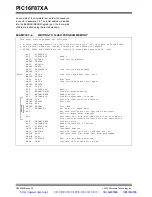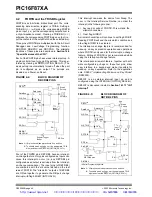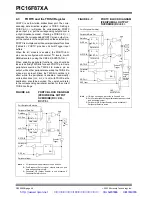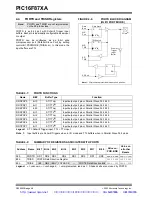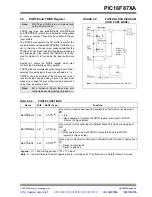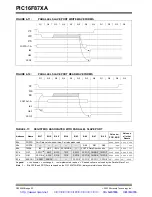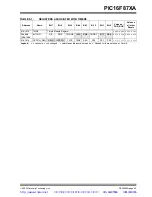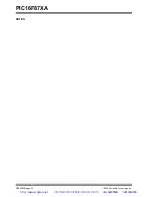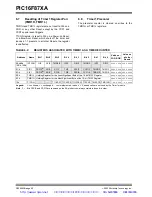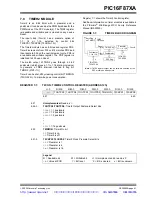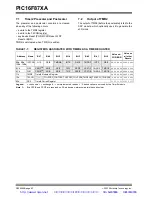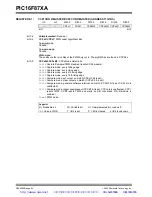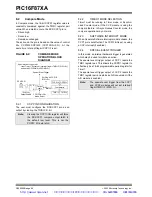
2003 Microchip Technology Inc.
DS39582B-page 51
PIC16F87XA
4.6
Parallel Slave Port
The Parallel Slave Port (PSP) is not implemented on
the PIC16F873A or PIC16F876A.
PORTD operates as an 8-bit wide Parallel Slave Port,
or microprocessor port, when control bit PSPMODE
(TRISE<4>) is set. In Slave mode, it is asynchronously
readable and writable by the external world through RD
control input pin, RE0/RD/AN5, and WR control input
pin, RE1/WR/AN6.
The PSP can directly interface to an 8-bit
microprocessor data bus. The external microprocessor
can read or write the PORTD latch as an 8-bit latch.
Setting bit PSPMODE enables port pin RE0/RD/AN5 to
be the RD input, RE1/WR/AN6 to be the WR input and
RE2/CS/AN7 to be the CS (Chip Select) input. For this
functionality, the corresponding data direction bits of
the TRISE register (TRISE<2:0>) must be configured
as inputs (set). The A/D port configuration bits,
PCFG3:PCFG0 (ADCON1<3:0>), must be set to
configure pins RE2:RE0 as digital I/O.
There are actually two 8-bit latches: one for data output
and one for data input. The user writes 8-bit data to the
PORTD data latch and reads data from the port pin
latch (note that they have the same address). In this
mode, the TRISD register is ignored since the external
device is controlling the direction of data flow.
A write to the PSP occurs when both the CS and WR
lines are first detected low. When either the CS or WR
lines become high (level triggered), the Input Buffer Full
(IBF) status flag bit (TRISE<7>) is set on the Q4 clock
cycle, following the next Q2 cycle, to signal the write is
complete (Figure 4-11). The interrupt flag bit, PSPIF
(PIR1<7>), is also set on the same Q4 clock cycle. IBF
can only be cleared by reading the PORTD input latch.
The Input Buffer Overflow (IBOV) status flag bit
(TRISE<5>) is set if a second write to the PSP is
attempted when the previous byte has not been read
out of the buffer.
A read from the PSP occurs when both the CS and RD
lines are first detected low. The Output Buffer Full
(OBF) status flag bit (TRISE<6>) is cleared
immediately (Figure 4-12), indicating that the PORTD
latch is waiting to be read by the external bus. When
either the CS or RD pin becomes high (level triggered),
the interrupt flag bit PSPIF is set on the Q4 clock cycle,
following the next Q2 cycle, indicating that the read is
complete. OBF remains low until data is written to
PORTD by the user firmware.
When not in PSP mode, the IBF and OBF bits are held
clear. However, if flag bit IBOV was previously set, it
must be cleared in firmware.
An interrupt is generated and latched into flag bit
PSPIF when a read or write operation is completed.
PSPIF must be cleared by the user in firmware and the
interrupt can be disabled by clearing the interrupt
enable bit PSPIE (PIE1<7>).
FIGURE 4-10:
PORTD AND PORTE
BLOCK DIAGRAM
(PARALLEL SLAVE PORT)
Data Bus
WR
Port
RD Port
RDx pin
Q
D
CK
EN
Q
D
EN
One bit of PORTD
Set Interrupt Flag
PSPIF (PIR1<7>)
Read
Chip Select
Write
RD
CS
WR
TTL
TTL
TTL
TTL
Note 1: I/O pins have protection diodes to V
DD
and V
SS
.
http://www.xinpian.net
提供单片机解密、IC解密、芯片解密业务
010-62245566 13810019655


